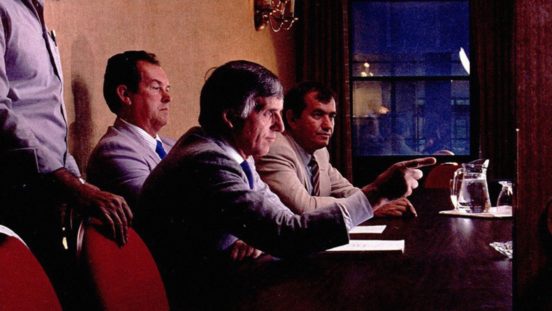Organizing Work will be publishing reviews of films, old and new, about unions and organizing. Written by workers and organizers, these will differ from standard movie reviews: they will draw out the lessons about organizing, or comment on the film’s depiction of unions, from the perspective of someone who has engaged in union activity. Here, Nick Driedger reviews the 1985 National Film Board of Canada documentary Final Offer. The review is particularly timely — sadly — given that General Motors is expected to announce today that they are closing all operations in Oshawa, Ontario.
Burly guys with chains around their necks and gold rings on their fingers, chomping on big cigars. This is the height of the old working class, its trade union politics in action — with all of the problems fully on display too, and completely unselfconsciously.
On the eve of the split between the Canadian Auto Workers (CAW) and United Auto Workers (UAW), some of the biggest names in Canadian labour history, Bob White and Buzz Hargrove (these guys carried with them as much of the trappings of power in Ontario in the 1980s as any Member of Parliament), duke it out against their central office in Detroit on one hand, and an unruly rank-and-file pulling wildcat strikes without their say-so on the other. They also seem to have some kind of dispute with the employer.
Scenes of high-tension bargaining and shouting over closed phone lines between union officials and captains of industry are broken up by vivid images of the alienation and hostility of life on the assembly line. Working class self-activity bleeds into official union channels: workers alternate between sabotaging the line by hitting the safety break to get a rest, and (taking their time) filing a grievance with their shop steward.
This documentary is not to be watched without a critical eye towards the union leaders. For example, at around 21:30 Bob White agrees to meet with the chief negotiator for General Motors — alone except for television cameras from the National Film Board of Canada. The fact that this meeting is recorded without a hint of apprehension is noteworthy. Here you have the chief negotiator for thousands of workers meeting with the company alone, in a nice hotel room, to see the offer from the big guy himself. Instead of exchanging offers as equal parties, and instead of being accountable to his people while at the table, White, an “independent-minded” person, goes into a situation where personal relationships trump collective force. In many unions this would be considered a serious mistake, if not crossing the line. But people like White believe that when it comes to this level of power, the rules are different.
Another moment to watch for is the reaction of the union leaders to the wildcat strikes that break out when the rank and file grows impatient and the uneasy transmission belt (no pun intended) between workers’ own capacity for organizing and the union machine begins to fray. The union leaders at the table take offense: many think this isn’t the result of the boiling anger of the people working on the assembly line but instead is simply political machinations inside the union. With strikes come power, but when you are bargaining the cessation of chaos is the bargaining chip. With workers out wildcatting independently of leadership, the union is walking a fine line between turning up the heat on the company and burning the whole house down.
One last point to consider is the role of Canadian nationalism in all of this. As mentioned above, this is the prequel to a story many Canadians know well: the CAW breaks away from its American parent body and forms the largest private sector union in the country. The role they play, though, is to repackage and sell the same deal the Americans got, dress it up in progressive nationalist rhetoric, and use that to consolidate power in their dispute with the UAW. In other words, nationalism plays the same role here it always does: it is largely a fight without content, just a useful tool for those who want to further their own agenda.
After all, the same General Motors plants in the city of Oshawa, Ontario which we see in the documentary are now closing. Many want to blame this outcome on the NAFTA trade talks. However, we need to look at why we are getting appeals for greater national unity in the face of diminishing returns in this sector. These plants are closing even after Jerry Dias, the current president of Unifor, which the CAW merged into, agreed to seriously downgrade the quality of the pensions, during concession bargaining in 2016. He defended this action by saying it would bring job security to the workers in the plant, and the community around them. Obviously that didn’t work. Populist appeals to nationalism are happening in the USA too, and workers there are losing ground the same way Canadian workers are. A Canadian version of the same UAW machine has clearly failed to address these problems.
Final Offer is probably one of the better union documentaries going because of its striking honesty. It shows unions warts and all — it paints a realistic picture of trade union politics without erring too much towards cynicism, while also keeping far enough away from simply being a propaganda piece. All of this conflict behind the scenes — not just between the union and the company, but between different union officials, and between union officials and shopfloor leaders — is a pretty good rebuttal to anyone who complains about the decline of the old trade unions or the lack of working class unity today.
Want to write a movie review for Organizing Work? Email us at contact@organizing.work !

